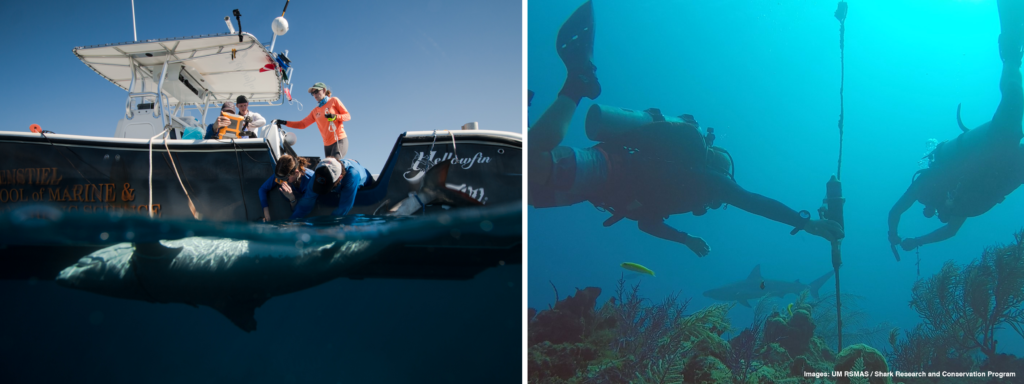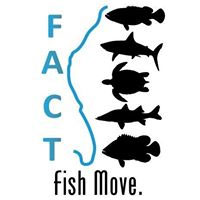
Project Overview
The tiger shark is the largest predatory fish in tropical seas. At Tiger Beach, a popular dive site in the Bahamas, boats lure tiger sharks within close proximity of SCUBA divers so that the dive tourists can see the sharks up-close. The overall goal of this project is to evaluate the behavioral ecology of tiger sharks at Tiger Beach and specifically to determine:
- Overall residency patterns of sharks within and outside of the Bahamas Shark Sanctuary
- Movement patterns within and in and out of Tiger Beach
- Effect of dive tourism on tiger shark behavior and movements
- Use of Tiger Beach as a mating ground, feeding area, or gestation ground
- Vulnerability of sharks to fishing exploitation outside of the Bahamas Shark Sanctuary
- Body condition and health impacts on shark movement patterns
To address these questions, this study combines acoustic telemetry, satellite tagging, blood-hormone analysis, and ultrasonography to analyze tiger sharks. To implement these methods, tiger sharks are carefully caught using a specialized fishing system and either secured to the side of the boat or placed onto a partially submerged platform where they can be quickly measured, a blood sample taken, tagged, and released. Historically, the reproductive biology of sharks has been studied by sacrificing the animals; however, in this study, in-water ultrasounds are performed while the shark is secured. The blood samples are taken for hormone analysis to determine reproductive status. Coupling these techniques (ultrasonography imaging and blood hormone analysis) allows researchers to determine the reproductive state (e.g., is a female tiger shark pregnant) and length of gestation.
Two types of tags are used to monitor the tiger sharks. To examine the large-scale movement patterns, satellite tags are affixed to their dorsal fins. To examine the fine scale residency patterns at Tiger Beach, acoustic tags are implanted in the abdomen of the sharks. The transmitters within the acoustic tag sends off an ultrasonic signal that is picked up by a series of hydrophones strategically positioned throughout Tiger Beach. These hydrophones record the date and time when an acoustically tagged tiger shark swims within about 500 m of a hydrophone.
Why this Matters
Tiger Beach is within the boundaries of the Bahamas Exclusive Economic Zone, where sharks are protected from all harvest due to the establishment of a Shark Sanctuary in 2011. If females spend their entire pregnancy and potentially give birth within Bahamian waters, then the sanctuary would indeed serve as an effective conservation tool for this species. However, if pregnant females spend little time within the sanctuary due to tourism pressure, and/or give birth outside the sanctuary, they may be vulnerable to exploitation when they move out, reducing the efficacy of the protected area.
Lead Organizations
Partners
- Austin Gallagher, Beneath the Waves Inc.
- Steve Cooke, Carleton University
- Mike Heithaus, Florida International University
- James Sulikowski, Arizona State University
Supported by
- Disney Conservation Fund
- Ocean Tracking Network
- International Seakeepers Society
- Herbert W. Hoover Foundation
Project Status
- Overall study is ongoing; acoustic telemetry portion has been completed and receivers removed from Tiger Beach
Contact
Resources & Publications
- Discovery’s Shark Week Violent Shark Sex (video)
- Discovery’s Shark Week First Ever Tiger Shark Sonogram (video)
- Virtual Reality Dive to observe Tiger Beach Acoustic Array (video)
- Hammerschlag N, Skubel RA, Sulikowski J, Irschick DJ, Gallagher AJ. (2018). A Comparison of Reproductive and Energetic States in a Marine Apex Predator (the Tiger Shark, Galeocerdo cuvier). Physiological and Biochemical Zoology 2018 91(4), 933-942.
- Hammerschlag N, Gutowsky LFG, Gallagher AJ, Matich P, Cooke SJ. (2017). Diel habitat use patterns of a marine apex predator (tiger shark, Galeocerdo cuvier) at a high use area exposed to dive tourism. Journal of Experimental Marine Biology and Ecology, 495: 24-34.
- Sulikowski J, Wheeler CR, Gallagher AJ, Prohaska BK, Langan JA, Hammerschlag N. (2016). Seasonal and life-stage variation in the reproductive ecology of a marine apex predator, the tiger shark Galeocerdo cuvier, at a protected female dominated site. Aquatic Biology, 24: 175-184.
- Hammerschlag N, Broderick AC, Coker JW, Coyne MS, Dodd M, Frick MG, Godfrey MH, Godley BJ, Griffin DB, Hartog K, Murphy SR, Murphy TM, Nelson ER, Williams KL, Witt MJ, Hawkes LA (2015). Evaluating the landscape of fear between apex predatory sharks and mobile sea turtles across a large dynamic seascape. Ecology, 96(8): 2117-2126.
- Irschick DJ, Hammerschlag N, (2014). Morphological scaling of body form in four shark species differing in ecology and life-history. Biological Journal of the Linnean Society 114(1), 126-135.
- Irschick DJ, Hammerschlag N. (2014). A new metric for measuring condition in large predatory sharks. Journal of Fish Biology; 85(3), 917-926.
- Gallagher AJ, Wagner DN, Irschick DJ, Hammerschlag N. (2014). Body condition predicts energy stores in apex predatory sharks. Conservation Physiology:2 DOI: 10.1093/conphys/cou022.
- Hammerschlag N, Gallagher AJ, Carlson JK. (2013) A revised estimate of daily ration in the tiger shark (Galeocerdo cuvier) with implications for assessing ecosystem impacts of apex predators. Functional Ecology, 27 (5): 1273-1274.
- Hammerschlag N, Gallagher AJ, Wester J, Luo J, Ault JS. (2012)(Cover) Don’t bite the hand that feeds: assessing ecological impacts of provisioning ecotourism on an apex marine predator. Functional Ecology, 26(3): 567-576.
- Hammerschlag N, Sulikowski J. 2011. Killing for Conservation: The Need for Alternatives to Lethal Sampling of Apex Predatory Sharks. Endangered Species Research 14: 135-140.
